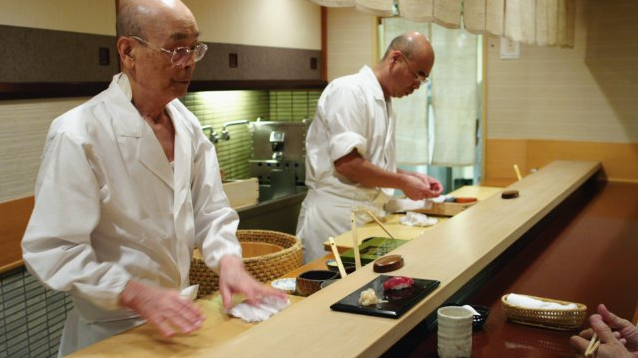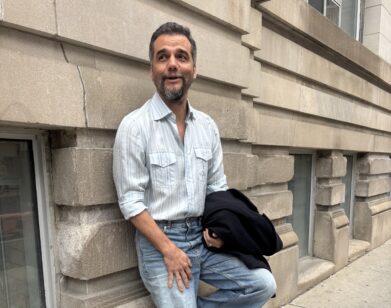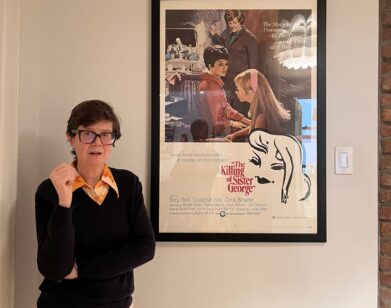David Gelb’s Tokyo Story

ABOVE: JIRO AND YOSHIKAZU ONO IN DAVID GELB’S JIRO DREAMS OF SUSHI.
Tucked away underneath Tokyo, in a nondescript subway station in the Ginza district, lies a revelation: Sukiyabashi Jiro, a tiny 10-seat restaurant that serves only sushi. Its proprietor, 85-year-old Jiro Ono, was the first chef in Japan to earn the über-prestigious three Michelin star rating, and filmmaker David Gelb’s new documentary on the subject makes it clear that Ono has earned it. Here is a man who treats sushi-making like both an art and a science, who massages his octopus meat for an hour to achieve the perfect tenderness, and who continually strives to be better even after the public has agreed he’s the very best.
Jiro Dreams of Sushi is more than a portrait of a master, though: it’s a family drama that delicately circles Ono’s relationships with his two sons—one of whom, Yoshikazu, is also his heir presumptive. It’s also the most beautifully photographed food movie you’re likely to see this year. We caught up with Gelb to discuss his unusual subject, how to make a film mouthwatering, and whether, after spending months with Jiro Ono, he’s been ruined for American sushi.
ALEXANDRIA SYMONDS: Can you tell me how you first heard of Jiro’s restaurant and got involved with the project?
DAVID GELB: Originally, I wanted to make a movie about a number of different sushi shops, maybe four different sushi shops. And, in my research, I was just searching around online, asking various chefs that I trusted and knew who were the best chefs, who should I talk to, which restaurant should I go visit. Jiro was always on the top of everybody’s list. He’s known really as a living legend of sushi. When I visited [Jiro’s] restaurant with Masaharu Morimoto, a food critic who appears in the film, I was just blown away by the quality of the sushi and just the experience of being served by Jiro and Yoshikazu. I think they’re just incredibly compelling and inspiring people. I thought, you know what, I’m just going to make the movie about Jiro; because the human story of Jiro and Yoshikazu makes this a feature film and not just a food TV special or something like that.
SYMONDS: How long did you end up spending with Jiro?
GELB: Two separate months, with a six-month period of editing in between the two shoots. I shot in January and then came back and edited for as long as I could, and then went back again in August—then I could decide what I still needed to shoot to make the film complete. Also, the menu is different in the winter than in the summertime because it’s, you know, fish. So I wanted to get the full spectrum of the restaurant.
SYMONDS: Documentarians end up with varying levels of involvement in their subjects’ lives—did you feel like you kind of became a part of Jiro’s life over those two months? Were you at the restaurant, hanging out with them, besides when you were shooting, or was it a more reserved, removed kind of relationship?
GELB: I think it started reserved, just because I didn’t want to scare them. The first few days, I didn’t even bring a camera. I wanted to just watch and observe, and meet all of the people that they work with in the fish market. Being a foreign presence already is a distraction, and having a camera would be twice the distraction. I just wanted to be as small a presence as possible. But over time, as our rapport got better, we started to talk to each other more. We would all eat at the fish market every morning. So, my goal was to kind of embed myself into their routine as much as possible without influencing what they were doing in any way. I wanted to be a fly on the wall as much as possible.
SYMONDS: You have all of these beautiful close-ups on fish, and the viewer gets a great sense watching the film for the texture and how it tastes and smells. With only sight and sound at your disposal, how did you approach the challenge of making a documentary that’s largely about food?
GELB: There are a few different techniques that can be employed to convey taste visually and audibly. We didn’t have Smell-o-vision, unfortunately.
SYMONDS: That wouldn’t have been a good thing.
GELB: Probably not. In photographing the food, we used very shallow focus so I could direct the viewer’s eye to the most delicious part of the fish. Showing the process, the trouble that they go through to make this kind of perfect-looking bite, also kind of creates an “emotional taste” in your mind. You respect the sushi because you’ve seen what it’s gone through to get there. So when he finally puts down the piece of octopus, you’ve experienced the troubles that they’ve gone through to produce this one little bite. And then on top of that I think it’s important to show people eating the food, and then you can see their reaction and their enjoyment. In one of the first scenes of the movie, the food critic, Morimoto, goes down to the restaurant and Jiro serves him a piece of sushi and he puts the whole thing in his mouth, and there’s enjoyment on his face. That combined with the appearance of it—you really get the sense that it’s delicious.
SYMONDS: Have you been able to go to sushi restaurants in LA since leaving Jiro, or has it just completely ruined American sushi for you?
GELB: It hasn’t made things easier. The main thing that’s changed about the way that I eat sushi is that I eat it a lot less often. When I do eat it, I’ll go to the best restaurant that I possibly can. Fortunately, in both New York and Los Angeles, there are some excellent sushi restaurants that have been directly influenced by Jiro and his contemporaries, and they have that kind of pursuit of perfection and pursuit of the perfect balance between the fish and the rice and the soy sauce to create that delicious flavor. My pet peeve after coming back from working on this is just the way that we mishandle rice in so many restaurants—there’s not the correct ratio of vinegar in it, it’s cold. Many American sushi restaurants simply do not understand how the rice should taste and the way the rice should be. But there are some that do, and I try to go to those restaurants.
SYMONDS: Perfectionism is obviously one of the biggest themes in the movie. Do you think all people have the capacity to be like Jiro, or do you think he was born with some trait that most people simply don’t have?
GELB: Not everybody has that dedication. For Jiro, it came just out of necessity, just to survive. When he was nine years old, his parents couldn’t support him anymore so they basically told him, “You’re going to have to leave and get a job and make your own way.” He became a presence at a restaurant not because he wanted to be the greatest sushi chef in the world, but because he needed to survive. Japanese culture is a very meticulous culture. One of the big theories in Zen Buddhism, which permeates a lot of the craftsmen in Japan, is the idea that there are no large tasks and small tasks, that they’re all of equal importance. So he’s a guy who has just been trying to focus on doing absolutely everything right, because that’s how he needed to survive—but it happens that he has such a great palate, such a sensitive palate, such incredible taste, that he was able to take this kind of situation and turn it into something really special. I think it’s a great thing that there are people who believe in this idea of perfection, and when you combine that with just raw talent, that’s where the real genius comes from. He has both the incredible work ethic and the talent; [he] know[s] in which direction to point his work to create something that’s very special and something that’s very meaningful to people.
SYMONDS: Early in the movie, someone says that they don’t consider Jiro to be an eccentric. Do you agree with that?
GELB: I think eccentric is a very subjective or relative term. I think that what he’s saying is that [Jiro’s] not crazy, he’s just a craftsman that’s trying to do the best that he can. I think when people watch the film, if you see it with an audience, you’ll hear people laugh at moments when he describes how incredibly intense he works. It’s sort of a response like: “Oh my goodness. He massages his octopus for an hour.” It sounds crazy, but he’s just doing it because he’s trying to make the absolute best product.
SYMONDS: When you were making the movie, did you find yourself drawing any parallels between how Jiro describes the sushi-making process and how you think of filmmaking—or did you try to resist that impulse?
GELB: No, no, absolutely not. Everything that Jiro says about sushi can be applied to everything [else]. [It’s] the process of basically repeating your routine: working every day to try to improve what you’re doing, and very honestly look[ing] at your work to make it better. During the editing process, as we were listening to him say this, we were constantly watching the edited cuts, showing the edited cuts to subjective test audiences, and doing everything that we could to honestly appraise what was working and what wasn’t working in the film—breaking the film down and rebuilding it, all the time, in as much a Jiro-like fashion as possible. It’s a daunting task. He’s a true master and the best at what he does, and this is my first film. He’s been making sushi for 60 years. I’m just trying to get the movie as close to his level as possible.
SYMONDS: Has he seen it?
GELB: He got to see the movie.
SYMONDS: Can I ask about his reaction?
GELB: I haven’t seen them since I finished the movie. I sent them a DVD before the Berlin Film Festival, because Jiro doesn’t travel anymore, but I was hoping that Yoshikazu would come to the festival to support the film and to help promote it. So I sent them a DVD, and I didn’t hear anything back for two weeks. I was very concerned that they didn’t like the movie or something, and then I finally got an email from Yoshikazu—who just asked me to blur out his license plate. That was really the only note, other than a few smaller minute things. They have such high standards that if they just accept something then I’m thrilled, and Yoshikazu did come to the premiere, so that’s kind of the seal of approval.
JIRO DREAMS OF SUSHI IS OUT IN LIMITED RELEASE NOW.






